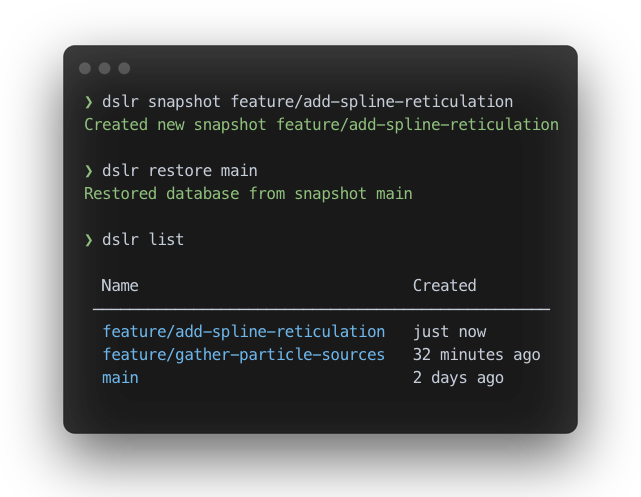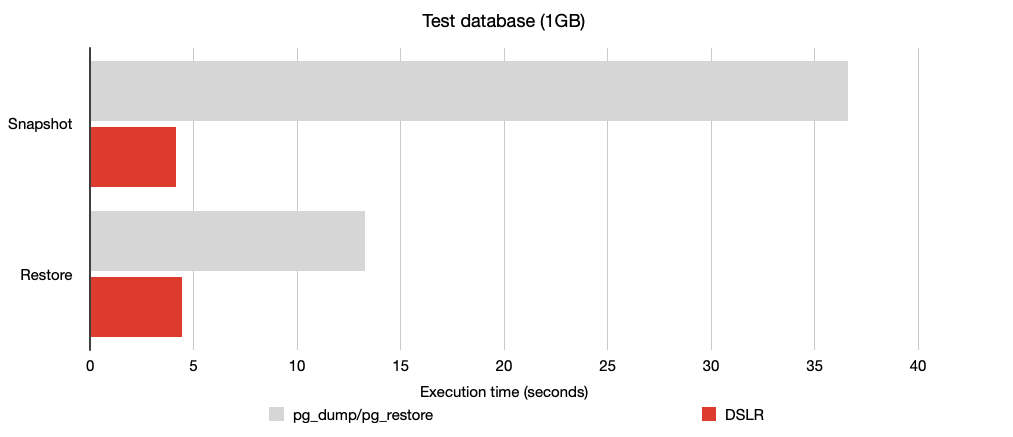Take lightning fast snapshots of your local Postgres databases.
Project description

Database Snapshot, List, and Restore
Take lightning fast snapshots of your local Postgres databases.
What is this?
DSLR is a tool that allows you to quickly take and restore database snapshots when you're writing database migrations, switching branches, or messing with SQL.
It's meant to be a spiritual successor to Stellar.
Important: DSLR is intended for development use only. It is not advisable to use DSLR on production databases.
Performance
DSLR is much faster than the standard pg_dump/pg_restore approach to snapshots.

DSLR is 8x faster at taking snapshots and 3x faster at restoring snapshots compared to the pg_dump/pg_restore approach.
Testing methodology
I spun up Postgres 12.3 using Docker, created a test database, and filled it with 1GB of random data using this script:
CREATE TABLE large_test (num1 bigint, num2 double precision, num3 double precision);
INSERT INTO large*test (num1, num2, num3)
SELECT round(random() * 10), random(), random() \_ 142
FROM generate_series(1, 20000000) s(i);
I used the following commands to measure the execution time:
time dslr snapshot my-snapshot
time dslr restore my-snapshot
time pg_dump -Fc -f export.dump
time pg_restore --no-acl --no-owner export.dump
I ran each command three times and plotted the mean in the chart.
Here's the raw data:
| Command | Run | Execution time (seconds) |
|---|---|---|
| dslr snapshot | 1 | 4.797 |
| 2 | 4.650 | |
| 3 | 2.927 | |
| dslr restore | 1 | 5.840 |
| 2 | 4.122 | |
| 3 | 3.331 | |
| pg_dump | 1 | 37.345 |
| 2 | 36.227 | |
| 3 | 36.233 | |
| pg_restore | 1 | 13.304 |
| 2 | 13.148 | |
| 3 | 13.320 |
Install
pip install DSLR[psycopg2] # or psycopg2-binary, pipx is also supported
Additionally, the DSLR export and import snapshot commands require pg_dump
and pg_restore to be present in your PATH.
Configuration
You can tell DSLR which database to take snapshots of in a few ways:
DATABASE_URL
If the DATABASE_URL environment variable is set, DSLR will use this to connect
to your target database.
export DATABASE_URL=postgres://username:password@host:port/database_name
dslr.toml
If a dslr.toml file exists in the current directory, DSLR will read its
settings from there. DSLR will prefer this over the environment variable.
url = 'postgres://username:password@host:port/database_name'
--url option
Finally, you can explicitly pass the connection string via the --url option.
This will override any of the above settings.
Usage
$ dslr snapshot my-first-snapshot
Created new snapshot my-first-snapshot
$ dslr restore my-first-snapshot
Restored database from snapshot my-first-snapshot
$ dslr list
Name Created
────────────────────────────────────
my-first-snapshot 2 minutes ago
$ dslr rename my-first-snapshot fresh-db
Renamed snapshot my-first-snapshot to fresh-db
$ dslr delete some-old-snapshot
Deleted some-old-snapshot
$ dslr export my-feature-test
Exported snapshot my-feature-test to my-feature-test_20220730-075650.dump
$ dslr import snapshot-from-a-friend_20220730-080632.dump friend-snapshot
Imported snapshot friend-snapshot from snapshot-from-a-friend_20220730-080632.dump
How does it work?
DSLR takes snapshots by cloning databases using Postgres' Template Databases functionality. This is the main source of DSLR's speed.
This means that taking a snapshot is just creating a new database using the main database as the template. Restoring a snapshot is just deleting the main database and creating a new database using the snapshot database as the template. So on and so forth.
License
MIT
Project details
Release history Release notifications | RSS feed
Download files
Download the file for your platform. If you're not sure which to choose, learn more about installing packages.















